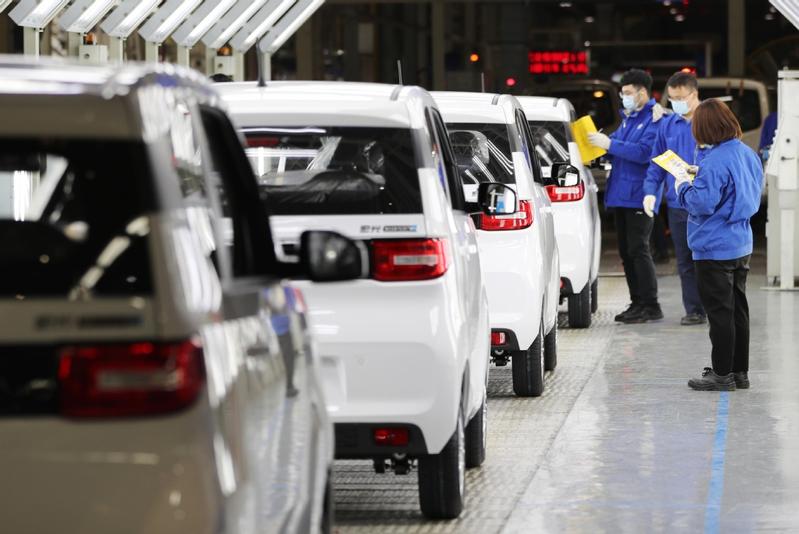 Workers examine new energy vehicles ready to roll off the production line at SGMW's branch in Qingdao, Shandong province, on Feb 17. (ZHANG JINGANG / FOR CHINA DAILY)
Workers examine new energy vehicles ready to roll off the production line at SGMW's branch in Qingdao, Shandong province, on Feb 17. (ZHANG JINGANG / FOR CHINA DAILY)
NANNING-Tan Boqian, a resident of Liuzhou, South China's Guangxi Zhuang autonomous region, is the latest fervent advocate of electric vehicles.
In recent years, as a major production base of SGMW and an important industrial city in Guangxi, Liuzhou has rolled out a series of measures to boost its auto industry and make it a model city for embracing new energy
"I bought it in March and drive it to work every day. The journey is about 20 kilometers, and the electric vehicle makes it very economical and eco-friendly," the 32-year-old said, adding the battery range of his car is about 120 km.
Tan's car, a Hongguang Mini EV, is an all-electric microcar manufactured by SAIC-GM-Wuling (SGMW), a joint venture between SAIC Motor, General Motors and Liuzhou Wuling Motors.
In recent years, as a major production base of SGMW and an important industrial city in Guangxi, Liuzhou has rolled out a series of measures to boost its auto industry and make it a model city for embracing new energy.
Fang Hua, deputy director of the local development and reform commission, said Liuzhou's infrastructure for new energy vehicles has significantly improved in recent years.
"More than 15,000 parking places for electric cars have been planned across the city through better use of public spaces in business areas and the interspace between roadside green belts," Fang said.
Leveraging a sound policy and a mature manufacturing industry, NEVs are gaining popularity in Liuzhou. As of April, the number of NEVs in the city reached 92,700 units, and about one in four vehicles running on the roads in Liuzhou is electric-powered.
"It is very convenient to park and charge the NEVs. We can simply open an app to search and find a parking spot nearby," Tan said.
"Young people need an affordable car for commuting while some families need it as an auxiliary tool for daily commutes. NEVs are also well-received as more cities opt for smart transportation and green economy," said Xu Bing, director of the planning department of SGMW.
ALSO READ: Government focus on NEVs switches from production to use
China, the world's biggest car market, has seen rising market enthusiasm for eco-friendly cars amid increasing public awareness of environmental protection and a push by the government.
Sales of NEVs in China more than doubled in the first half of the year as production and demand continued to recover, data from the China Association of Automobile Manufacturers showed.
Total NEV sales rose 201.5 percent year-on-year to reach over 1.2 million in the January-June period, equal to total sales in the whole of 2019. The NEV market penetration rate also increased from 5.4 percent at the beginning of 2021 to 9.4 percent for the first half of the year.
Young people, especially, are leading the trend to embrace NEVs.
"Many of my peers and 20-somethings prefer to purchase NEVs and some personalize their cars to make them more unique," said Tan. "When I bought my car, I immediately put a cartoon sticker on it so that I can spot it on the street right away".
As a leading NEV manufacturer in Liuzhou, SGMW's sales of small NEVs have exceeded 460,000 units since 2017. Sales growth continued to climb in the first half, with 189,644 units of small NEVs having been sold, exceeding its annual sales last year, the company said.
Among the Hongguang Mini EV owners, the post-90s generation accounted for 72 percent, and 60 percent of them were women. They are also the key force driving new growth in businesses such as vehicle refitting and paint jobs.
Liuzhou's air quality has improved remarkably thanks to continuous efforts in promoting clean energy and NEVs. Last year, the ratio of good air days in its urban areas was 96.7 percent, up 5.2 percentage points year-on-year, official data showed.
"We are striving to further promote the use of new energy in the public transportation sector and explore new business patterns to further expand its application," Fang said.


